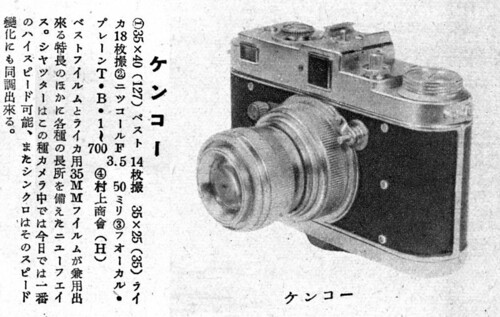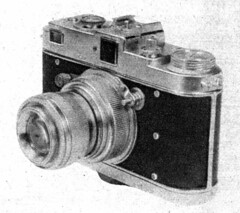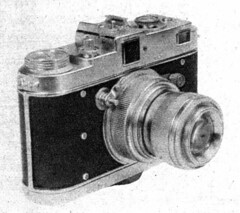Difference between revisions of "Kenko 35"
Rebollo fr (talk | contribs) (extremely interesting documents found) |
Hanskerensky (talk | contribs) (Added Category:3) |
||
| (18 intermediate revisions by 4 users not shown) | |||
| Line 1: | Line 1: | ||
{{Japanese Baby and Four | {{Japanese Baby and Four | ||
| − | |image=[http://www.flickr.com/photos/ | + | |image=[http://www.flickr.com/photos/camerawiki/46854752325/in/pool-camerawiki/ https://live.staticflickr.com/65535/46854752325_3dc0292829_m_d.jpg]<br>''Picture from ''[[Photo Art]]'' December 1949. {{public domain Japan new}}'' |
}} | }} | ||
| − | The '''Kenko 35''' (ケンコー35) is a Japanese camera announced in 1949 by the distributor | + | The '''Kenko 35''' (ケンコー35) is a Japanese camera announced in 1949 by the distributor Murakami Shōkai (predecessor of [[Kenko]]). It is not known if it was developed by the Murakami company itself or by some external company or independent designer. |
| − | The camera was advertised in the February 1949 issues of | + | == Original documents == |
| + | The camera was advertised in the February 1949 issues of {{AR}} and {{KG}}.<REF> Advertisement in {{FAR}} February 1949, p.28. The advertisement in ''[[Kohga Gekkan]]'' is mentioned in {{Kokusan}}, p.351. </REF> The advertisement in {{AR}} only shows the name "Kenko 35" (ケンコー35) and a small picture. | ||
{| class="plainlinks" align="center" style="text-align: center;" | {| class="plainlinks" align="center" style="text-align: center;" | ||
| − | || [http://www.flickr.com/photos/ | + | || [http://www.flickr.com/photos/camerawiki/47717474812/in/pool-camerawiki/ https://live.staticflickr.com/65535/47717474812_926d2a26a6.jpg] |
|- | |- | ||
| − | || ''Advertisement by [[Kenko|Murakami Shōkai]] in | + | || ''Advertisement by [[Kenko|Murakami Shōkai]] in {{AR}} February 1949. {{public domain Japan new}}'' |
|} | |} | ||
| − | The camera was also featured in the December 1949 issue of | + | The camera was also featured in the December 1949 issue of {{FAR}}, in an article about Japanese cameras.<REF> Column in {{FAR}} December 1949, p.40. The features are repeated in {{Kokusan}}, p.351. </REF> This has a larger version of the same picture and gives some information about the camera, whose name is only given as "Kenko" (ケンコー). The camera is said to take fourteen 3.5×4cm exposures on [[127 film]] or eighteen 25×35mm exposures on [[35mm film]]. At the time, 35mm film was sold in pre-loaded cassettes for 36 or 20 exposures (when used for the very close 24×36mm format); the mention of 18 instead of 36 exposures might mean that the Kenko does not take regular pre-loaded cassettes but different thinner cassettes, specifically designed to fit inside the compartments for 127 film. |
| + | |||
| + | The camera is said to have a focal plane shutter giving T, B, 1–700 speeds with adjustable flash synchronization;<REF> Column in {{FAR}} December 1949, p.40: "flash synchronization can be adjusted to match the selected speed" (シンクロはそのスピード変化にも同調出来る). </REF> this is the first Japanese shutter to have a top speed faster than 1/500. The lens is said to be a [[Nikon|Nikkor]] 50/3.5. The exact price is not given, but the price category is ¥30,000 to ¥40,000. | ||
{| class="plainlinks" align="center" style="text-align: center;" | {| class="plainlinks" align="center" style="text-align: center;" | ||
| − | || [http://www.flickr.com/photos/ | + | || [http://www.flickr.com/photos/camerawiki/46855770035/in/pool-camerawiki/ https://live.staticflickr.com/65535/46855770035_3d4f0c6b7b.jpg] |
|- | |- | ||
| − | || ''Picture and column in | + | || ''Picture and column in {{FAR}} December 1949. {{public domain Japan new}}'' |
|} | |} | ||
| − | The picture in the December article is the same as in the February advertisement. It clearly shows that the Kenko 35 is an all-new camera | + | == Only available picture == |
| + | The picture in the December article is the same as in the February advertisement. It clearly shows that the Kenko 35 is an all-new camera and does not copy any Western design. The body has rounded ends, and the back seems to be removable together with the bottom plate for film loading. The film is advanced by a knob at the left end, as seen by the photographer. The film advance is certainly controlled by some auto-stop mechanism and exposure counter, but nothing is clearly visible. (The non-standard 3.5×4cm format rules out the possibility of manual advance via a red window.) No rewind control is visible either; maybe the camera could only use [[35mm film]] with an additional take-up cassette. | ||
| + | |||
| + | The viewfinder and rangefinder are combined inside the top housing. The viewfinder window is at the middle, and is squarish. It presumably contains some device to indicate the field of view for both 3.5×4cm vertical exposures and 25×35mm horizontal exposures, but nothing is clearly visible. The rangefinder window is at the right end. There is an accessory shoe above the viewfinder. Some sort of pin is visible in front of the accessory shoe; it might be a flash synch connector or a viewfinder frame selector. A knob is visible on the right, certainly controlling the shutter speeds. It is not known if the shutter is wound separately or together with the film advance: the advance knob seems too far from the speed knob to allow internal coupling via a train of gears. | ||
| + | |||
| + | {| class="plainlinks" align="center" style="text-align: center;" | ||
| + | || [http://www.flickr.com/photos/camerawiki/46854752325/in/pool-camerawiki/ https://live.staticflickr.com/65535/46854752325_3dc0292829_m_d.jpg] [http://www.flickr.com/photos/camerawiki/32828595037/in/pool-camerawiki/ https://live.staticflickr.com/65535/32828595037_1e83c86d84_m_d.jpg] | ||
| + | |- | ||
| + | || ''Picture in ''[[Photo Art]]'' December 1949: the way it was published (left) and laterally reversed (right).''<br>''It is not known for sure which one is correct. {{public domain Japan new}}'' | ||
| + | |} | ||
| + | The shutter release is to the left, unlike most other cameras. (This arouses the suspicion that the picture might be laterally reversed. If the picture were reversed, this would mean that the speed knob controlling the shutter's main drum was to the left, itself an unusual arrangement.)<REF> The only available picture appears the same way in the two documents, which means nothing. </REF> The release button itself seems to contain a thread for a cable release. Some control is visible at the front, at about the same level; its exact function is unclear: it looks like a second release button, locked by a lever to prevent accidental actuation, but it might as well be a self-timer control or plain shutter lock, or be related to flash synchronization or Bulb exposures. | ||
| + | |||
| + | The lens is probably interchangeable, but this is not confirmed. The pictured lens looks faster than a 50/3.5. It has a large milled focusing ring driven by a tab, and another large milled ring at the front. No engraving is visible on the lens rim. The lens barrel looks (slightly) collapsible, but this is unclear. Its shape is reminiscent of contemporary [[Nikon|Nippon Kōgaku]] products (such as some early Nikkor 5cm f/2, 8.5cm f/2 or 13.5cm f/4 designs). | ||
| + | |||
| + | == The concept == | ||
| + | {| class="plainlinks floatright" width=220px style="text-align: center;" | ||
| + | || [http://www.flickr.com/photos/camerawiki/46855832575/in/pool-camerawiki/ https://live.staticflickr.com/65535/46855832575_b27960300c_t_d.jpg] | ||
| + | || [http://www.flickr.com/photos/camerawiki/46854752325/in/pool-camerawiki/ https://live.staticflickr.com/65535/46854752325_3dc0292829_t_d.jpg] | ||
| + | |- | ||
| + | || ''{{with permission}}'' | ||
| + | || ''{{public domain Japan new}}'' | ||
| + | |- | ||
| + | | colspan="2" | ''Kenko 35 versus [[Gokoku and Ricohl|Ricohl]]. Picture of the Ricohl courtesy of [http://www.pacificrimcamera.com/ Pacific Rim Camera].'' | ||
| + | |} | ||
| + | The Kenko 35 was the last focal-plane-shuttered Japanese camera to take [[127 film]]. This class of camera appeared before 1945, with the [[Olympus Standard]], the [[Gokoku and Ricohl]] and maybe a few others. The main prompt for their design was that perforated [[35mm film]] was not readily available in Japan at the time.<REF> {{Sugiyama}}, p.50, says that "35mm film was in short supply, most of it being diverted to the military". </REF> After 1945, 35mm film became easy to access and this motive disappeared; the only remaining reason to make such camera was the larger exposure size allowed by 127 film. | ||
| − | The | + | The dual-film ability was perhaps adopted to allow the camera to take color film, only readily available as perforated 35mm film. It was surely also motivated by the success met by contemporary 35mm cameras: the name "Kenko 35" used in the advertisement by [[Kenko|Murakami]] is an allusion to 35mm film, not to the 3.5×4cm format. It is not known if the ability to take 35mm film was considered from the start of the project or was added as an afterthought, modifying a design originally intended for the more standard 3×4cm format. One wonders whether the camera incorporates a sprocket shaft to drive the perforated film. |
| − | + | With hindsight, the whole dual-film concept of the Kenko camera had little practical utility and was probably doomed to failure: it was giving vertical or horizontal pictures depending on the film type, and may have introduced complications in the film advance mechanism or necessitated special cassettes for 35mm film. | |
| − | No surviving example of the Kenko 35 is known, and it seems that the camera was not | + | No surviving example of the Kenko 35 is known, and it seems that the camera was not sold in any quantity, if at all. |
== Notes == | == Notes == | ||
| Line 31: | Line 58: | ||
== Bibliography == | == Bibliography == | ||
| − | * | + | * {{AR}} February 1949. Advertisement by [[Kenko|Murakami Shōkai]], p.28. |
* {{Showa10}} Item 505. | * {{Showa10}} Item 505. | ||
| − | * | + | * {{FAR}} December 1949. "Ōru kokusan kamera" (オール国産カメラ, All of Japanese cameras). Pp.34–41. |
| − | The Kenko 35 is not listed in | + | * {{Zukan}} (On focal-plane-shuttered cameras using 127 film. The Kenko 35 is not listed in this document.) |
[[Category: Japanese 35mm rangefinder]] | [[Category: Japanese 35mm rangefinder]] | ||
[[Category: Japanese 127 film]] | [[Category: Japanese 127 film]] | ||
[[Category: K]] | [[Category: K]] | ||
| + | [[Category:3|35 Kenko]] | ||
Latest revision as of 05:16, 10 July 2022
The Kenko 35 (ケンコー35) is a Japanese camera announced in 1949 by the distributor Murakami Shōkai (predecessor of Kenko). It is not known if it was developed by the Murakami company itself or by some external company or independent designer.
Original documents
The camera was advertised in the February 1949 issues of Ars Camera and Kohga Gekkan.[1] The advertisement in Ars Camera only shows the name "Kenko 35" (ケンコー35) and a small picture.

|
| Advertisement by Murakami Shōkai in Ars Camera February 1949. (Image rights) |
The camera was also featured in the December 1949 issue of Photo Art, in an article about Japanese cameras.[2] This has a larger version of the same picture and gives some information about the camera, whose name is only given as "Kenko" (ケンコー). The camera is said to take fourteen 3.5×4cm exposures on 127 film or eighteen 25×35mm exposures on 35mm film. At the time, 35mm film was sold in pre-loaded cassettes for 36 or 20 exposures (when used for the very close 24×36mm format); the mention of 18 instead of 36 exposures might mean that the Kenko does not take regular pre-loaded cassettes but different thinner cassettes, specifically designed to fit inside the compartments for 127 film.
The camera is said to have a focal plane shutter giving T, B, 1–700 speeds with adjustable flash synchronization;[3] this is the first Japanese shutter to have a top speed faster than 1/500. The lens is said to be a Nikkor 50/3.5. The exact price is not given, but the price category is ¥30,000 to ¥40,000.

|
| Picture and column in Photo Art December 1949. (Image rights) |
Only available picture
The picture in the December article is the same as in the February advertisement. It clearly shows that the Kenko 35 is an all-new camera and does not copy any Western design. The body has rounded ends, and the back seems to be removable together with the bottom plate for film loading. The film is advanced by a knob at the left end, as seen by the photographer. The film advance is certainly controlled by some auto-stop mechanism and exposure counter, but nothing is clearly visible. (The non-standard 3.5×4cm format rules out the possibility of manual advance via a red window.) No rewind control is visible either; maybe the camera could only use 35mm film with an additional take-up cassette.
The viewfinder and rangefinder are combined inside the top housing. The viewfinder window is at the middle, and is squarish. It presumably contains some device to indicate the field of view for both 3.5×4cm vertical exposures and 25×35mm horizontal exposures, but nothing is clearly visible. The rangefinder window is at the right end. There is an accessory shoe above the viewfinder. Some sort of pin is visible in front of the accessory shoe; it might be a flash synch connector or a viewfinder frame selector. A knob is visible on the right, certainly controlling the shutter speeds. It is not known if the shutter is wound separately or together with the film advance: the advance knob seems too far from the speed knob to allow internal coupling via a train of gears.
 
|
| Picture in Photo Art December 1949: the way it was published (left) and laterally reversed (right). It is not known for sure which one is correct. (Image rights) |
The shutter release is to the left, unlike most other cameras. (This arouses the suspicion that the picture might be laterally reversed. If the picture were reversed, this would mean that the speed knob controlling the shutter's main drum was to the left, itself an unusual arrangement.)[4] The release button itself seems to contain a thread for a cable release. Some control is visible at the front, at about the same level; its exact function is unclear: it looks like a second release button, locked by a lever to prevent accidental actuation, but it might as well be a self-timer control or plain shutter lock, or be related to flash synchronization or Bulb exposures.
The lens is probably interchangeable, but this is not confirmed. The pictured lens looks faster than a 50/3.5. It has a large milled focusing ring driven by a tab, and another large milled ring at the front. No engraving is visible on the lens rim. The lens barrel looks (slightly) collapsible, but this is unclear. Its shape is reminiscent of contemporary Nippon Kōgaku products (such as some early Nikkor 5cm f/2, 8.5cm f/2 or 13.5cm f/4 designs).
The concept

|

|
| (Image rights) | (Image rights) |
| Kenko 35 versus Ricohl. Picture of the Ricohl courtesy of Pacific Rim Camera. | |
The Kenko 35 was the last focal-plane-shuttered Japanese camera to take 127 film. This class of camera appeared before 1945, with the Olympus Standard, the Gokoku and Ricohl and maybe a few others. The main prompt for their design was that perforated 35mm film was not readily available in Japan at the time.[5] After 1945, 35mm film became easy to access and this motive disappeared; the only remaining reason to make such camera was the larger exposure size allowed by 127 film.
The dual-film ability was perhaps adopted to allow the camera to take color film, only readily available as perforated 35mm film. It was surely also motivated by the success met by contemporary 35mm cameras: the name "Kenko 35" used in the advertisement by Murakami is an allusion to 35mm film, not to the 3.5×4cm format. It is not known if the ability to take 35mm film was considered from the start of the project or was added as an afterthought, modifying a design originally intended for the more standard 3×4cm format. One wonders whether the camera incorporates a sprocket shaft to drive the perforated film.
With hindsight, the whole dual-film concept of the Kenko camera had little practical utility and was probably doomed to failure: it was giving vertical or horizontal pictures depending on the film type, and may have introduced complications in the film advance mechanism or necessitated special cassettes for 35mm film.
No surviving example of the Kenko 35 is known, and it seems that the camera was not sold in any quantity, if at all.
Notes
- ↑ Advertisement in Photo Art February 1949, p.28. The advertisement in Kohga Gekkan is mentioned in Kokusan kamera no rekishi, p.351.
- ↑ Column in Photo Art December 1949, p.40. The features are repeated in Kokusan kamera no rekishi, p.351.
- ↑ Column in Photo Art December 1949, p.40: "flash synchronization can be adjusted to match the selected speed" (シンクロはそのスピード変化にも同調出来る).
- ↑ The only available picture appears the same way in the two documents, which means nothing.
- ↑ Sugiyama, p.50, says that "35mm film was in short supply, most of it being diverted to the military".
Bibliography
- Ars Camera February 1949. Advertisement by Murakami Shōkai, p.28.
- Asahi Camera (アサヒカメラ) editorial staff. Shōwa 10–40nen kōkoku ni miru kokusan kamera no rekishi (昭和10–40年広告にみる国産カメラの歴史, Japanese camera history as seen in advertisements, 1935–1965). Tokyo: Asahi Shinbunsha, 1994. ISBN 4-02-330312-7. Item 505.
- Photo Art December 1949. "Ōru kokusan kamera" (オール国産カメラ, All of Japanese cameras). Pp.34–41.
- Sugiyama, Kōichi (杉山浩一); Naoi, Hiroaki (直井浩明); Bullock, John R. The Collector's Guide to Japanese Cameras. 国産カメラ図鑑 (Kokusan kamera zukan). Tokyo: Asahi Sonorama, 1985. ISBN 4-257-03187-5. (On focal-plane-shuttered cameras using 127 film. The Kenko 35 is not listed in this document.)